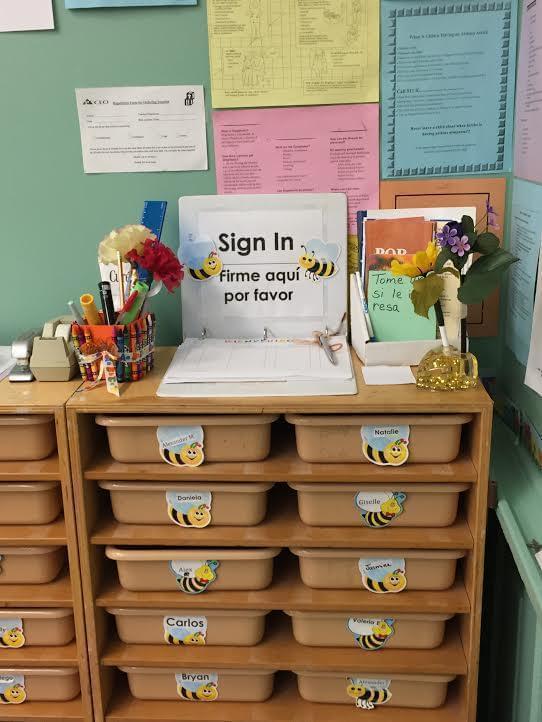As Schools Return From Winter Break, Some Students Still Out For The Holidays

David del Pozo teaches ESL and bilingual classes at Von Steuben. Cass Herrington/Illinois Public Radio
Illinois public school students officially return from winter break this week. But some students, many of them Mexican-American, are still south of the border for the holidays.
For many Mexicans, the arrival of December means a whole host of celebrations and religious days, like the el Día de Reyes, or the Three Kings' Day, on Jan. 6 and the feast of Our Lady of Guadalupe on Dec. 12.
“Every time I go to Mexico I try to visit the Basilica de Guadalupe,” Juan Marin, of Peoria, said.
Marin isn’t going to mass in Mexico City this year. He has to work. Instead, Marin is celebrating Guadalupe at St. Mary’s Cathedral downtown. He makes it a prerogative to take his five kids to visit relatives in Mexico, at least once a year.
“There it’s like me seeing myself when I was young. And they love it," Marin said. "They ask me, ‘Are we going to Christmas this year, or for the summer?’”
Last year, Marin took his family on the three-day road trip for Christmas. They stayed as long as they could, two weeks, so that his kids didn’t miss school days.
“For me it’s definitely not enough,” Marin said.
He says, he wishes they had a whole month off, so they didn’t miss out on family traditions and celebrations.

A bilingual classroom at Von Steuben Middle School in Peoria.
Unlike Marin, some families are gone longer than the school calendar allows. As Peoria’s school district and others across the country become increasingly diverse, teachers are starting to take notice.
“Family time is important, and I have a hard time myself, have difficulty penalizing kids for going and spending time with their families,” David del Pozo, an English as a Second Language and bilingual teacher at Von Steuben Middle School, said.
Many of his students are from Mexico. Del Pozo says around November, he typically knows which of his students will be gone longer than the official winter break.
“They’re respectful, they ask if they can leave early, but I think for us, each school kind of handles things a little differently,” del Pozo said.
The attendance policy for middle schoolers says students who've had more than five unexcused absences a quarter receive an “F” for that grading period.
“And I personally feel bad for a student who has been going to school, has been working hard and then all of the sudden because their parents choose to go to Mexico and they have no choice, they have an 'F,'" del Pozo said.
When he raised the issue to District leadership, del Pozo says, he was told to handle it on a case-by-case basis. He says he typically has about five children in his class missing this time of year.
“I think it’s something we need to deal with, and really, it’s not just you know, Hispanic families, or families going to Mexico," del Pozo said. "There could be other families who have religious vacations or other things where this could be the case for them too.”
Del Pozo says he doesn’t like the gray area. He says he and some of his colleagues would like to see a district-wide policy.
Peoria District 150 Spokesman Chris Copelan says a new attendance policy is in the works.
“We have a committee working on an overall district attendance plan to launch for next school year,” Copelan said.
But he adds, so far, the numbers of students taking extended holiday breaks are too small to address.
“There are specific teachers and specific classrooms that may see impacts around the holidays, but it has not become a district problem as a whole," Copelan said. "We have many other priorities to address that will be part of our attendance plan and how to address the issues that would make the most impact within our district.”
But at least one national non-profit aimed at tracking and reducing chronic school absences says those missed days add up. Hedy Chang is the director of Attendance Works, a national education policy initiative. She says even a small group of student absences around the holidays have considerable impact on teachers and other students.
“When they come back to the classroom now the teacher’s not quite sure how to teach because you’ve got different kids coming in at different times," Chang said. "It’s actually affecting the education of the kids in the classroom.”
Chang says as school districts across the country become more diverse, many are developing absentee policies that encompass religious and ethnic minorities, not just those with families in Mexico. San Francisco, for example, recently added two days off for Chinese New Year.
“That way if lots of kids were going to take it off for lunar new years, then that’s fine," Chang said. "And I think it speaks to this issue of how inconsistent attendance is more problematic than taking it off.”
Perhaps more important than a policy, Chang says, is communicating attendance policies with parents.
“Especially those who are least familiar with our school systems about what goes on and how kids have to be in school every day in order to achieve and succeed,” Chang said.
And she adds, the conversations need to happen, not as families prepare to leave for the holidays, but well before the beginning of the school year.
